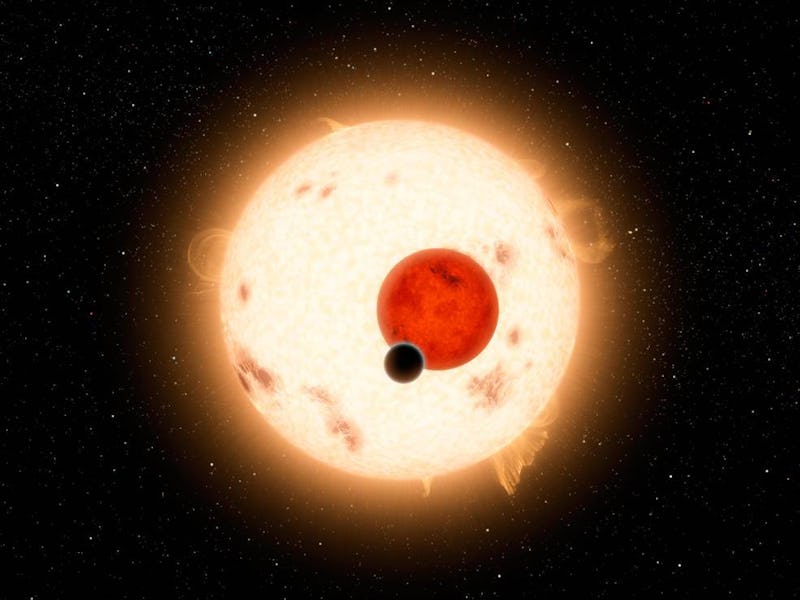This giant exomoon may have lost an evolutionary race to its rival
Kepler-1625b-i is “a failed giant planet core."

In October of last year, astronomers spotted evidence of a potential exomoon orbiting a Jupiter-like planet about 4,000 light-years away from Earth. The discovery was the first of its kind: No other exomoons (moons orbiting planets outside our solar system) had ever been observed before.
However, research published Wednesday in Science Advances suggests that this is no regular exomoon.
Kepler-1625b-i may have actually started off as a planet in the making before its growth was stunted by its planetary rival.
Bradley Hansen, Ph.D., professor of physics and astronomy at UCLA and sole author of the new study, recalls his surprise at the initial discovery of a large exomoon because its size did not fit with existing models of moon formation. Because the exomoon was much larger than any other moon, it led Hansen to explore just how this exomoon came to be.
“I was looking for an alternative model for a satellite to make another satellite,” Hansen tells Inverse.
This artist's rendering shows what it may look like for the planet Kepler-1625b and its moon Kepler-1625b-i to pass across the star Kepler-1625.
The exomoon is around 1.5 percent the mass of its host planet Kepler-1625b, and it orbits around the planet at a distance of 1.9 million miles — about eight times farther than the distance at which our moon orbits Earth. However, because the exomoon is so large, it would appear twice as large from the surface of the planet.
Popular theories suggest that moons are either captured by the gravitational pull of the planets that they orbit, or that they formed from the debris that spilled over from their host planet following a giant impact.
But Hansen is not convinced that either method would have birthed Kepler-1625b-i.
Instead, his new study suggests that both the exomoon and its host planet started off as planetary cores on a journey to turn into full-blown planets.
“Then it’s a race,” Hansen says. “Each is growing in mass…one is slightly ahead and the two are racing with each other to grow until one of them gets ahead and the other is left with nothing.”
Kepler-1625b-i’s host had an advantage in this race because it is a large, gaseous planet, and these Jupiter-like planets grow rapidly by capturing gas in their atmosphere.
“Usually we describe this process in terms of single bodies: A Jupiter planet grows and grows,” Hansen says. “If you can imagine, there’s nothing to restrict it.”
"A former competitor, something that was captured and dragged down."
Once that gas-filled planet becomes big enough, its gravitational pull grows so strong that it can attract its more feeble companion in its orbit.
“A failed giant planet core,” is how Hansen describes the exomoon. “A former competitor, something that was captured and dragged down.”
This cosmic tragedy could make astronomers rethink how planets form and evolve over time. Rather than looking at how one planet forms on its own, Hansen believes that we should consider the effects that some planetary bodies have on each other’s growth processes.
Hansen says that it’s safe to assume that our own Jupiter may have also had an effect on surrounding smaller bodies in the solar system.
“The one thing it points out is the importance of considering planetary system formation as a whole,” he says. “We should consider the effects that forming planets have on each other, and this is the extreme version of that.”
Abstract: The large size and wide orbit of the recently announced exomoon candidate Kepler-1625b-i are hard to explain within traditional theories of satellite formation. We show that these properties can be reproduced if the satellite began as a circumstellar co-orbital body with the original core of the giant planet Kepler-1625b. This body was then drawn down into a circumplanetary orbit during the rapid accretion of the giant planet gaseous envelope, a process termed “pull-down capture.” Our numerical integrations demonstrate the stability of the original configuration and the capture process. In this model, the exomoon Kepler-1625b-i is the protocore of a giant planet that never accreted a substantial gas envelope. Different initial conditions can give rise to capture into other co-orbital configurations, motivating the search for Trojan-like companions to this and other giant planets.